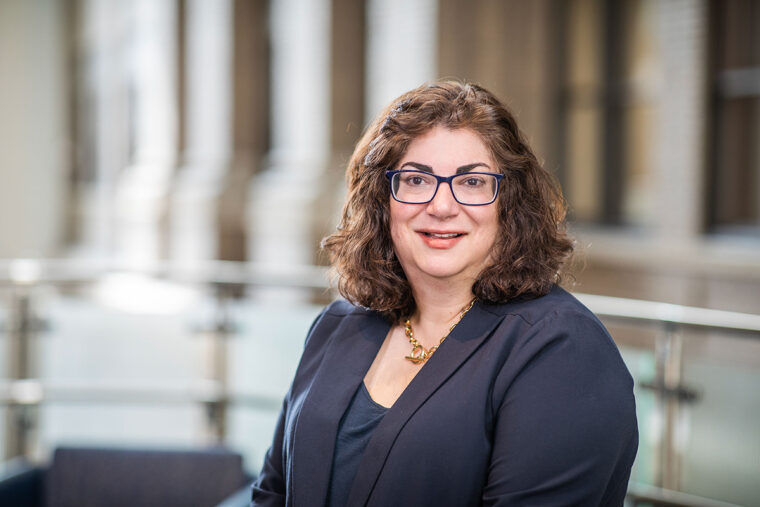
Pamela K. Woodard, MD, head of the Department of Radiology and director of Mallinckrodt Institute of Radiology (MIR) at Washington University School of Medicine in St. Louis, has been elected to the National Academy of Medicine - one of the highest honors in health and medicine. Election to the academy recognizes individuals who have demonstrated outstanding professional achievement and commitment to service.
Woodard, also the Elizabeth E. Mallinckrodt Professor of Radiology, is one of 100 new members elected to the academy this year. She was honored for her leadership as director of Mallinckrodt Institute of Radiology, one of the largest academic radiology departments in the U.S., ranking third in funding from the National Institutes of Health (NIH). Woodard's election reflects a distinguished career as a researcher and clinician - marked by major advances in the development and clinical translation of cardiac imaging techniques that have improved clinicians' ability to diagnose and treat cardiovascular disease - as well as her dedication to inspiring the next generation of physician-scientists in the field.
"Dr. Woodard's groundbreaking work in cardiothoracic imaging and her commitment to training radiologists have advanced imaging science and the practice of radiology in exceptional ways," said David H. Perlmutter, MD, Executive Vice Chancellor for Medical Affairs, the Spencer T. and Ann W. Olin Distinguished Professor and the George and Carol Bauer Dean of WashU Medicine. "Her election to the National Academy of Medicine is a well-deserved honor that reflects key contributions to improving patient care in the area of radiology. We're so proud to celebrate this recognition with her and grateful for all she contributes to the WashU Medicine community."
Among her accomplishments is the clinical translation of a technique to decrease motion artifact (an image disturbance due to movement) in MRI scans caused by a patient's breathing. This advance has allowed three-dimensional MRI imaging to be used for diagnostic scans of cardiac patients. The first clinical use of the technique occurred at WashU Medicine.
She also led a team that has provided new tools to help doctors characterize atherosclerotic plaques, which are accumulations of fats and other materials in blood vessels that can cause cardiovascular events such as heart attacks or strokes. The nanoparticle-based PET imaging radiotracer her group developed selectively adheres to specific receptors in the plaques in the blood vessels, potentially allowing physicians to better identify their patients' risk of stroke. Woodard has also led other first-in-human trials translating WashU-developed PET radiotracers into people.
Woodard is a pioneer in developing the use of multidetector spiral CT - a device that collects multiple CT images simultaneously - to detect pulmonary embolisms, which are potentially deadly blood clots that travel into the blood vessels of the lungs. Woodard worked on the technique as a resident at Duke University. She also was a principal investigator of the clinical trial that eventually established the imaging technique as the standard of care for diagnosing blood clots in the lungs.
A committed educator, Woodard has led the Training Opportunities in Translational Imaging Education and Research (TOP-TIER) program at MIR since its inception in 2017. The NIH-funded program trains radiology residents and fellows in advanced translational imaging research.
Woodard is a fellow of the American Association for the Advancement of Science, the American Institute for Medical and Biological Engineering, the American College of Radiology and the American Heart Association. She was awarded the Gold Medal from the North American Society for Cardiovascular Imaging in 2025, the Radiological Society of North America's Outstanding Researcher award in 2021 and, in 2015, the Distinguished Investigator Award given by the Academy of Radiology and Biomedical Imaging Research, of which she is currently president. In 2024-2025 she served as president of the American College of Radiology.
Woodard earned her bachelor's and medical degrees from Duke. She then completed an internship in internal medicine at the University of North Carolina at Chapel Hill. She returned to Duke for her residency in radiology and came to WashU Medicine for a clinical fellowship in cardiothoracic radiology, before joining the WashU Medicine faculty in 1997.
About WashU Medicine
WashU Medicine is a global leader in academic medicine, including biomedical research, patient care and educational programs with more than 3,000 faculty. Its National Institutes of Health (NIH) research funding portfolio is the second largest among U.S. medical schools and has grown 83% since 2016. Together with institutional investment, WashU Medicine commits well over $1 billion annually to basic and clinical research innovation and training. Its faculty practice is consistently among the top five in the country, with more than 2,000 faculty physicians practicing at 130 locations. WashU Medicine physicians exclusively staff Barnes-Jewish and St. Louis Children's hospitals - the academic hospitals of BJC HealthCare - and Siteman Cancer Center, a partnership between BJC HealthCare and WashU Medicine and the only National Cancer Institute-designated comprehensive cancer center in Missouri. WashU Medicine physicians also treat patients at BJC's community hospitals in our region. With a storied history in MD/PhD training, WashU Medicine recently dedicated $100 million to scholarships and curriculum renewal for its medical students, and is home to top-notch training programs in every medical subspecialty as well as physical therapy, occupational therapy, and audiology and communications sciences.
Originally published on the WashU Medicine website






